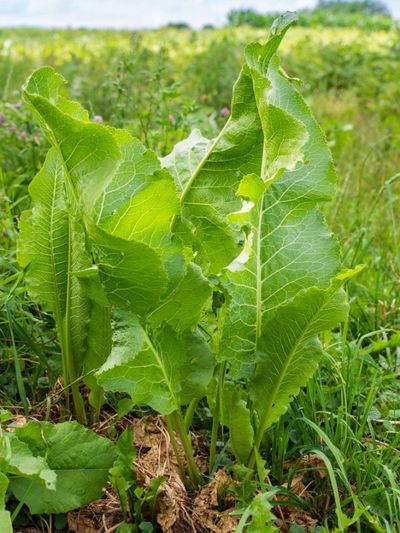Before You Plant Horseradish…
The best way to be certain you’ll be able to control your horseradish plant is to containerize it from the beginning. Whether or not you sink the container into the ground is up to you, but planting it first in a barrel, bucket or some other kind of sturdy pot can help confine the roots so they don’t spread to areas where they’re not wanted. If you use a clay or ceramic container, however, the roots are likely to break through and spread, regardless.
How to Get Rid of Horseradish
If you’re faced with the task of eliminating an out-of-control horseradish plant, it’s important to understand the plant. Horseradish grows from crown or root cuttings, and the smallest piece of root can yield a new plant. We wish other plants were this hardy! The most effective way of controlling horseradish is to dig up the plant every year, and try to remove as much of the root as possible. It’s labor intensive, but with horseradish, there aren’t a lot of choices. Dig a large hole around the horseradish plant, making it deep enough to reach underneath the bottom-most tip of the root, and large enough to leave plenty of room around the sides of the plant. With a large garden fork, lift the root from the ground, keeping in mind that any small shoots left in the soil will develop a new root. Look carefully into the hole to see if there are any white pieces of root remaining. It’s likely that you’ll eventually see another plant pop up, and you’ll need to repeat the procedure, perhaps more than once. To our knowledge, there is no chemical or natural agent that will kill a wildly growing horseradish besides this process of digging it. You may need to repeat this task until the plant stops coming up.
Alternatives for Controlling Horseradish
If you have a stubborn crop of persistent horseradish, you may want to consider simply mowing it, and seeding over the area with grass seed. This doesn’t eliminate the plant, but it may stop it from spreading with regular mowing. If nothing else works, you can consider simply camouflaging the plants, letting them become part of your landscape scenery. They do produce a pretty white flower that pollinators will love in the spring and, if you have no other alternatives, you may grow to appreciate its weed-like appearance. One thing you should absolutely not do is rototill over the plants. Tilling breaks the roots into small pieces that will proliferate in new horseradish plants that can spread far and wide.
